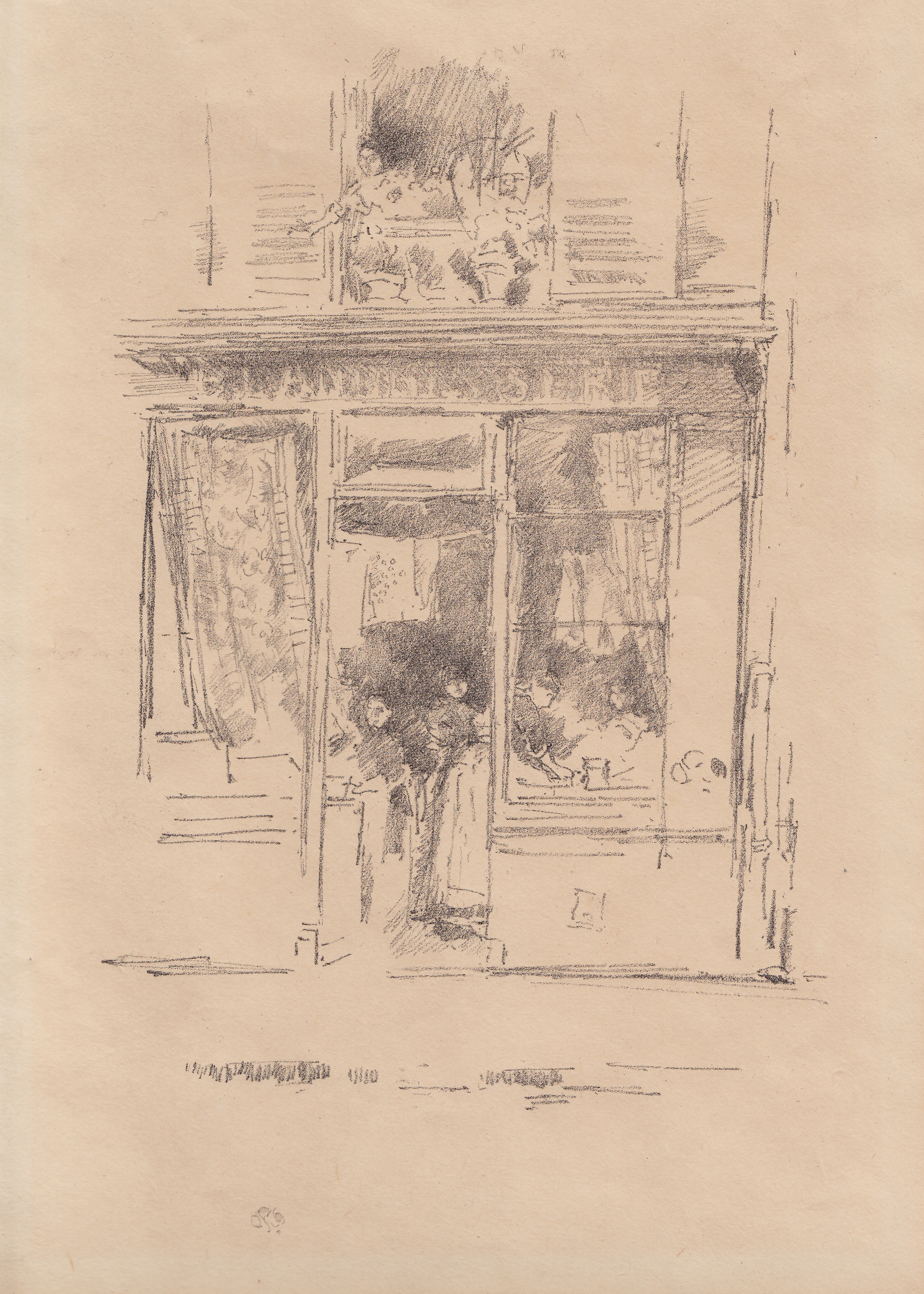
|
|
The
Laundress
[La Blanchisseuse de la Place Dauphine]
Spink, Stratis, and
Tedeschi 93
transfer lithograph , 1894, a superb impression, signed below, center left , with the butterfly monogram in pencil, and annotated in pencil along the lower left margin: "The Laundress / (Blanchisseuse de la rue Dauphine)"; exceptionally printed on medium-fine cream laid Japan vellum*, with full
margins, deckle edges left and below, one of 25 impressions printed in 1894 by Thomas Way**,
some slight mat staining along the outer margins, and very slight
lightstaining over the image, with old hinges at the upper corners, verso,
otherwise
in quite excellent
condition
P. 230 x 157 mm., S. 330 x 240 mm.

|
Whistler here again takes up a rather commonplace subject, one of his most favorite: the doorway/shopfront façade. In England of course, but also in his travels from Paris, to Brussels, Amsterdam and Venice, he tirelessly explored this basic feature of the urban landscape with remarkable perspicacity.
This particular scene is in Paris, a laundry shop on the Place
Dauphine, which is located to the west of the île de la Cité, opening
onto the Pont Neuf.
The refined yet succinct
treatment of the architecure is evident, alternating spare lines that
organize the façade with deft drawing of detail and fine parallel
shading. The scene is enlivened by the three laundresses seen
through the doorway, one apparently ironing in the window, and another woman opening
the shutters above.
We know too from his
correspondence with Way that Whistler was rather fussy about his
transfer paper (an incessant process of trial and error). This technique allowed him to work directly d'après nature. The present lithograph is printed from a very fine-grained transfer paper, which renders exquisite detail.
Spink, Stratis and Tedeschi reference
10 impresssions in public collections (not including two in the
Bibliothèque Nationale, Paris, which we have consulted), only one
of which is on Japan paper; the present impression
is thus exceedingly rare. 
Furthermore, our impression is
annotated (right), and this corresponds to a similar annotation on an unsigned impression in
the British Museum, which they describe as "inscribed, possibly in T. R. Way's hand."*** :
"The Laundress, (Blanchisseuse de la Place Dauphine)"
We
have only seen one other similar inscription, again with variants,
though in the same hand (Milwaukee Art Museum, catalogue reference:
M2004.329) which reads:
"The Laundress (La Blanchisseuse de la Rue Dauphine)".
Insofar as this same hand is present on other lifetime
impressions of Whistler lithographs, it is most certainly traceable to
the workshop itself, and the attribution to Way is quite plausible,
making the present impression all that much more significant.
Lastly, Whistler most highly
considered this particular lithograph. In a letter to
Thomas Way, on 7 August, 1894, he referred to it as:
"what
I fancy is perhaps the best drawing I have done - The "Blanchisseuse de
la Place Dauphine" - It has no stump and ought to come out perfectly..."
(NB There is also an etching of the same subjet, with variants, Mme Pelletier, Blanchisserie, Paris (Kennedy 438, Glasgow 481) of which there is only one known impression, in the Freer Gallery of Art, Washington, DC.)
* Harriet Stratis (personal communication, 2013) refers to this vellum as shu paper, meaning "mould-made" in Japanese, and emphasizes Whistler's preference for such papers. In The Lithographs of James McNeill Whistler, Volume 2, page 298, she further writes, "Whistler
saw the paper on which his lithographs and etchings were printed as
integral to the printmaking process. He coveted fine old
eighteenth-century paper and luxurious sheets of Japanese paper." On page 303, she specifies "The Japanese paper most prized by Whistler was a thick luxurious golden-toned Japanese vellum with pronounced deckle edges."
** Thomas Way was
Whistler's exclusive lithographer for decades, and it was under his
direct influence that Whistler first took up the medium in 1878.
*** See
http://www.britishmuseum.org/research/collection_online/collection_object_details.aspx?objectId=1346306&partId=1



